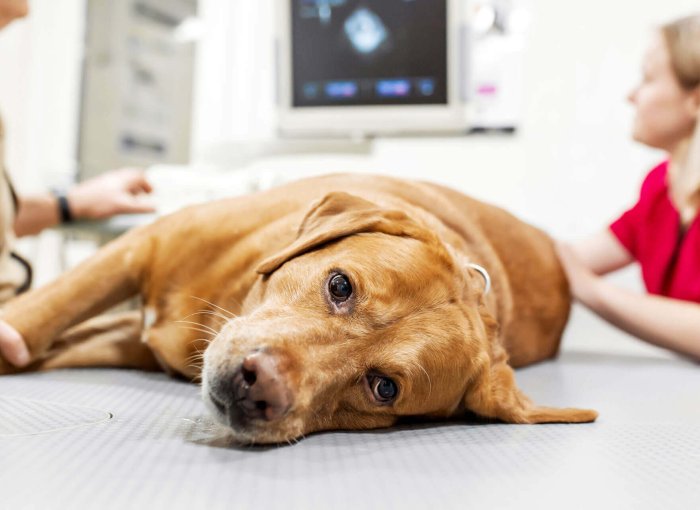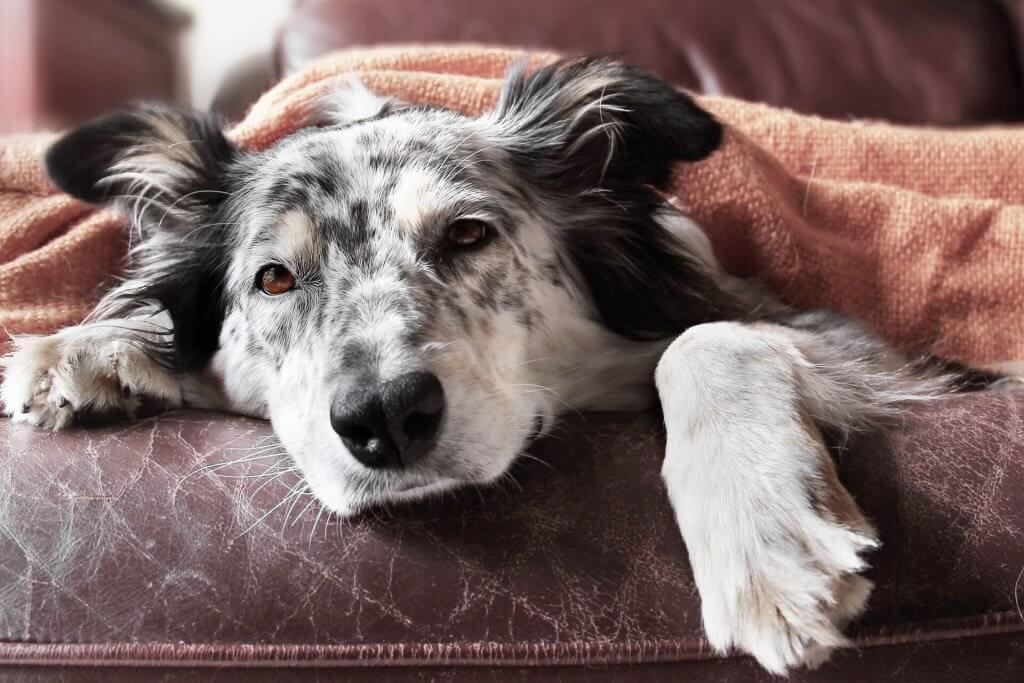Skin Cancer In Dogs: Warning Signs, Prevention & Treatment
No one wants to think about their pet getting cancer, but skin cancer can affect dogs of all breeds. Learn the types, warning signs, prevention and treatment options for dog skin cancer, so you can be prepared to take the best care of your furry friend.

Unfortunately, our dogs can get cancer and this is a fact of life we must be prepared for as loving dog parents. Did you know that skin cancers are the most common tumors in dogs – accounting for approximately one third of all tumors? You might not think much about it because your dear friend is covered with hair and protected from the sun. Luckily, when caught early, many cases of skin cancer in dogs can be treated successfully.
Which dog breeds are most likely to develop cancer?
Dogs with light-colored skin or a thin coat are most at risk for sun-related skin cancer1.
There may be a genetic basis for the development of certain cancers and even though cancer can strike any breed of dog at any age, there are certain breeds that have higher instances of the disease.
- Boxers
- Scottish Terriers
- Golden Retrievers
- Norwegian Elkhounds
- German Shepherds
- Bull Mastiffs
- Weimaraners
- Basset Hounds
are among the breeds that most commonly develop cancer. Large and giant breeds, like Great Danes and Saint Bernards, are much more likely to suffer from bone cancer. Older dogs are also much more in the “risk zone” than younger ones. It is important to be familiar with the diseases to which your dog might have a breed predisposition. When in doubt, you can always contact a vet.
What does skin cancer look like on a dog?
Skin cancer on dogs can show up in several different ways, depending on which form of cancer it is. Keep an eye out for any unusual bumps, lumps, sores, scabs, raised patches or discoloration on your dog’s skin. The spots might be pink, red, black, brown, or grey in color. It’s best to make an appointment with your vet as soon as possible if you notice something strange on your dog’s skin, or if your dog appears to be in pain.
If you find a tumor on your dog, try not to touch it, and don’t let your dog chew, lick or scratch it. Doing so could lead to further complications.
Symptoms of skin cancer in dogs
Cancer can be hard to detect in dogs but if you pay attention, you can find a lot of the warning signs and symptoms yourself. Dogs with skin cancer may experience the following symptoms:
- Abnormal swelling that persists or continues to grow
- Sores that do not heal
- Weight loss
- Loss of appetite
- Bleeding or discharge from any body opening
- Sores that do not heal for several months (especially in areas where the hair is white or light colored)
- Difficulty eating or swallowing
- Hesitation to exercise
- Persistent lameness or stiffness
- Difficulty in breathing and urinating
If your pet has any of these cancer symptoms, or any other signs of illness in dogs, be sure to consult with your veterinarian right away.

Types of skin cancer in dogs
There are different types of skin cancer that can develop in dogs. The good news is that not all tumors are malignant (cancerous). Common types of skin cancer in dogs include:
- Mast cell tumors
- Squamous cell carcinoma
- Malignant melanoma
- Histiocytic cell tumors
- Fibrosarcoma
Let’s take a closer look at the three most common types of skin cancer in dogs: mast cell tumors, squamous cell carcinoma and malignant melanoma.
Mast cell tumors
MCTs are one of the most common types of skin cancer in dogs. Mast cells are the cells in the body that release histamine, a chemical that causes allergic reactions in dogs. Tumors made of mast cells can grow anywhere on a dog’s skin as well as in internal organs like the spleen, intestine, liver, and bone marrow.
Signs of mast cell tumors in dogs
- Common: a raised, possibly red or swollen bump or lump on or under the skin; stomach or intestine ulcers, which may cause lethargy, vomiting, loss of appetite, and black stools
- Possible: anaphylaxis (allergic reaction)
- Rare: swollen lymph nodes, spleen, or liver, round or swollen belly
Most often, mast cell tumors are found on the legs, lower belly, and chest of dogs. Most dogs with mast cell tumors only develop one tumor[1]. Mast cell tumors are considered one of the most treatable types of cancer in dogs.
Dogs breeds most susceptible to mast cell tumors
- Pugs
- Boxers
- Boston Terriers
- Bull Terriers
- Rhodesian Ridgebacks
- Labrador Retrievers
Mixed breed, older dogs are also most susceptible to MCTs. This type of skin cancer is most often seen in dogs aged 8 to 10 years old.
Squamous cell carcinoma
Another very common type of dog skin cancer is squamous cell carcinoma. The term squamous refers to the top layer of the skin, where tumors can develop in the cells. Commonly found around the nails, paw pads, abdomen, ears, back or nose, it may be mistaken as a minor abrasion. But its essential to diagnose and treat it early, otherwise squamous cell carcinoma can spread to surrounding tissue or other parts of the body. This type of cancer is often triggered by exposure to the sun and usually appears as a single lesion.
Dogs breeds most susceptible to squamous cell carcinoma
- Scottish Terriers
- Pekingese
- Boxer Dogs
- Poodles
- Norwegian Elkhounds
- Whippets
- Beagles
- Dalmations
- Bull Terriers
Fine coated, light-haired and light-skinned dogs are more prone to squamous cell carcinoma.
Malignant melanoma
Melanomas often appear as raised, sometimes dark bumps near the dog’s mouth or nail bed.
Many melanomas in dogs are benign, but sometimes they can be malignant. In the latter case, they pose a serious risk to your dog’s health and well-being and require urgent treatment. Fast growing, this type of cancer can spread quickly to other parts of the body.
Any dog breed can get melanoma, and it is typically found in dogs 10 years or older. Additionally, small dog breeds, black dogs, and male dogs are more susceptible to developing this form of skin cancer. Schnauzers and Scottish Terriers are also more at risk.
What causes skin cancer in dogs?
In most cases, it’s difficult to say what causes skin cancer in dogs. That’s because cancer is a “multifactorial” disease, which means it has no known single cause. Environmental and hereditary (genetic) factors may play a role. For instance, genetic mutations have been found to contribute to the development of mast cell tumors.
How to prevent skin cancer in dogs
Overall, prevention is difficult because we don’t know the causes of most cancers. Rather than trying to prevent cancer, identifying it early and treating it quickly is the best strategy.
Bringing your dog to the vet, to get professional guidance, is always a good idea. The vet will know exactly what works on different breeds and different types of cancer. However, keep in mind that different vets might have different views on the best way to treat the disease. Therefore, it’s always a good idea to seek out a second opinion.
Spaying your dog may prevent your dog from getting cancer. If you spay a dog before the first heat you’ll reduce the chance of cancer, just because of the hormonal influence. Exposure to the sun has also been shown to cause a higher incidence of skin cancer. Therefore, be aware of the sun and provide your dog with plenty of shade during the summer.
Dog In Heat? Here’s Everything You Need To Know.
How is dog skin cancer treated?
The cancer treatment vary and depends on the type and stage of cancer. The most common treatments include surgery, chemotherapy, radiation and immunotherapy. A mixture of therapies is also a possibility.
Some dog owners might not like the above mentioned treatments, in which case palliative care, including pain relief, is offered. Some cancers can be cured, and some not.
If your dog’s cancer is not curable, there are still many things you can do to improve the life of your dear friend. Good nutrition and lots of love and care can definitely enhance your dog’s quality of life.




